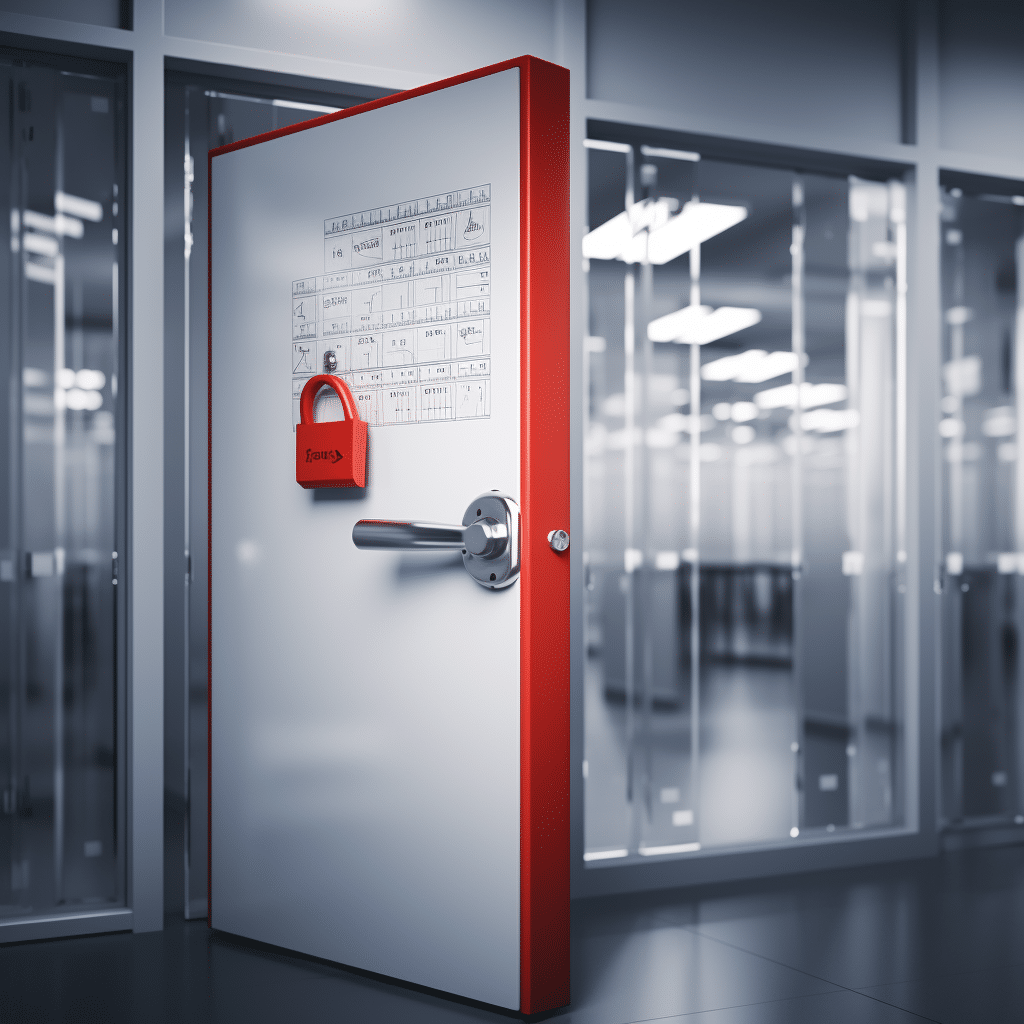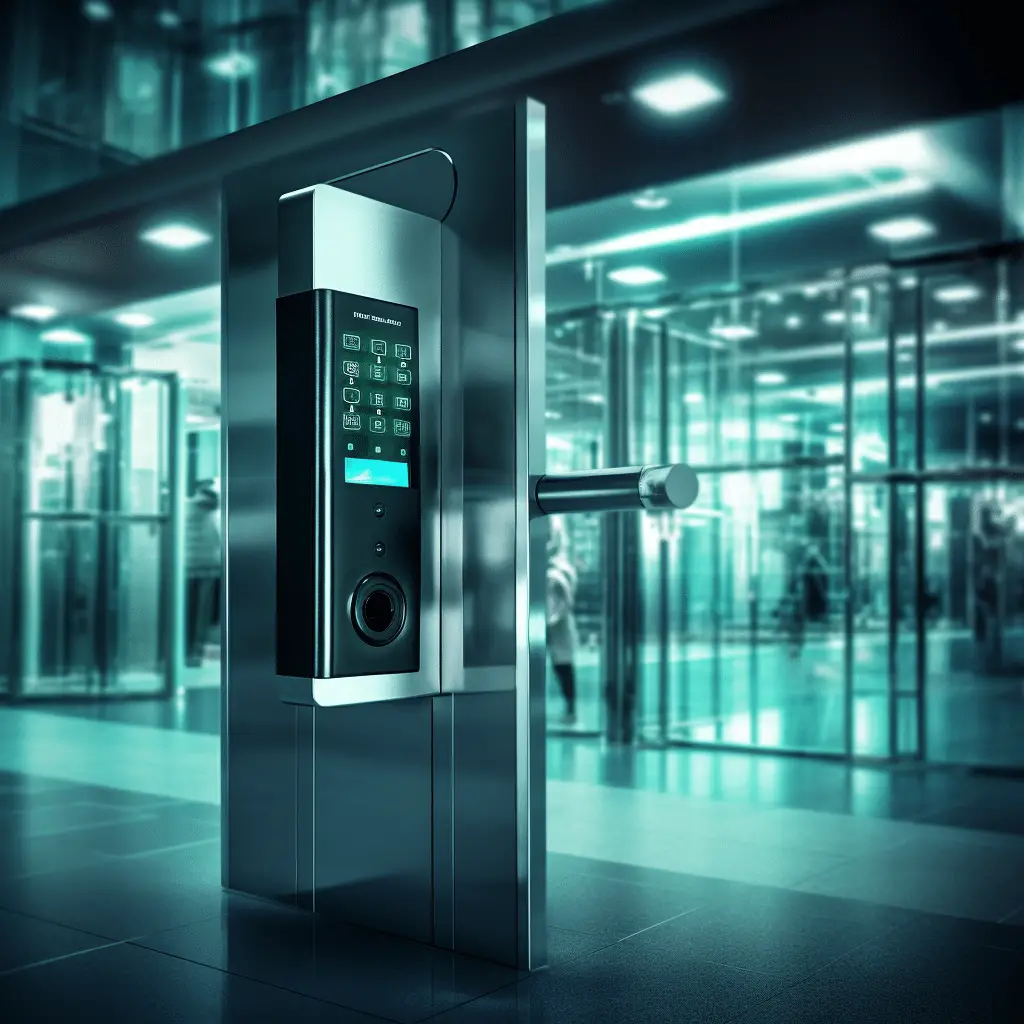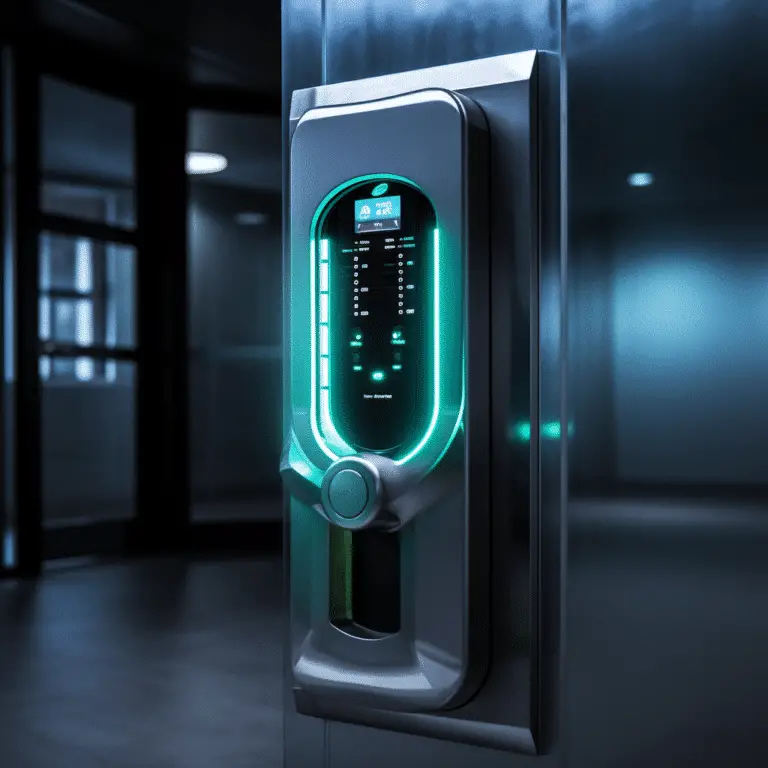Conducting a comprehensive access control system audit is crucial for organizations looking to improve security, reduce breaches, and ensure compliance. By thoroughly evaluating your access control systems, you can identify any weaknesses or vulnerabilities that may exist and take appropriate measures to address them.
Key Takeaways:
- Conducting an access control system audit helps improve security and reduce breaches.
- An audit ensures compliance with regulations and industry standards.
- Evaluating access control systems helps identify vulnerabilities and weaknesses.
- Addressing vulnerabilities is essential to maintaining a strong security posture.
- Regular audits are key to ensuring ongoing security and compliance.
Understanding the Importance of Access Control System Audits
An access control system audit is a critical process for organizations aiming to enhance security, minimize breaches, and ensure compliance. By comprehensively evaluating the access control system, potential vulnerabilities can be identified, compliance with regulations and industry standards can be assessed, and the risk of unauthorized access can be mitigated. Regular access control system audits enable organizations to proactively detect and address weaknesses, reinforcing the overall security posture.
The primary importance of access control system audits lies in safeguarding sensitive information and valuable assets. By conducting thorough audits, organizations can identify vulnerabilities in the system that may expose critical data to risks. These vulnerabilities can include inadequate user access rights, ineffective access controls, or security gaps in physical access points. Through systematic evaluation, organizations can take proactive measures to address these vulnerabilities and fortify their security measures.
Moreover, access control system audits also serve as a means to evaluate compliance with regulations and industry standards. Ensuring compliance is essential to avoid penalties, reputational damage, and legal consequences. By conducting compliance gap analysis, organizations can identify areas where they may fall short and take appropriate actions to address these gaps.
Benefits of Access Control System Audits
Access control system audits offer several benefits for organizations:
- Enhanced Security: By detecting and addressing vulnerabilities, organizations can strengthen their security measures and protect sensitive information.
- Compliance: Audits help organizations identify non-compliant areas and implement necessary changes to meet regulatory requirements.
- Risk Mitigation: By proactively identifying and addressing weaknesses, organizations can reduce the risk of unauthorized access and potential security breaches.
“Conducting regular audits allows organizations to identify and address vulnerabilities in their access control systems, establishing a solid foundation for security and compliance.”
| Importance of Access Control System Audits | Key Benefits |
|---|---|
| Enhances security | Strengthens protection of sensitive information and assets |
| Ensures compliance | Identifies non-compliant areas and facilitates necessary changes |
| Mitigates risk | Reduces the risk of unauthorized access and security breaches |

Planning and Preparation for Access Control System Audits
Before conducting an access control system audit, it is crucial to plan and prepare accordingly. By establishing clear objectives and defining the scope of the audit, you can ensure a thorough assessment of your access control systems. This planning phase allows you to identify key areas to be assessed and gather all necessary documentation for the audit.
Defining Audit Objectives
When planning for an access control system audit, it is important to establish clear objectives. These objectives should align with your organization’s goals and include specific areas of focus, such as user access rights, physical access points, or compliance with regulations. Clearly defining your audit objectives will help guide the assessment process and ensure that all relevant areas are thoroughly evaluated.
Determining the Scope
The scope of the audit refers to the boundaries within which the assessment will be conducted. It defines the specific systems, locations, or processes that will be included in the evaluation. Determining the scope is essential to ensure that the audit remains focused and manageable. It also helps allocate resources effectively and ensures that all critical areas are adequately assessed.
During the planning phase, it is important to consider factors such as the size and complexity of your organization, the sensitivity of the information being protected, and any regulatory requirements that may apply. By carefully defining the scope, you can ensure that the audit is comprehensive and provides meaningful insights into your access control systems.
| Audit Objectives | Scope |
|---|---|
| 1. Evaluate user access rights and permissions | Include all user roles and access levels within the organization |
| 2. Assess the effectiveness of access controls | Review all access control mechanisms, including authentication methods and authorization processes |
| 3. Evaluate physical access points | Include all entry points to the organization’s facilities, such as doors, gates, and parking areas |
| 4. Ensure compliance with relevant regulations | Include all applicable laws, regulations, and industry standards that govern access control systems |
By carefully planning and preparing for an access control system audit, you can lay the foundation for a successful assessment. Defining clear audit objectives and determining the scope of the evaluation will help ensure that all critical areas are thoroughly assessed. With proper planning, you can conduct a comprehensive audit that identifies vulnerabilities, assesses compliance, and supports the overall security and integrity of your access control systems.
In-Depth Assessment of Access Control Systems: Conducting an Audit
Once the planning and preparation phase is complete, it is time to move on to the next crucial step in conducting an access control system audit: performing an in-depth assessment of your systems. This phase involves a thorough evaluation of various aspects of your access control systems and procedures to identify any weaknesses or vulnerabilities that may exist.
To ensure a comprehensive assessment, it is important to follow established audit procedures. These procedures typically include reviewing user access rights and permissions, evaluating the effectiveness of access controls, and assessing the security of physical access points. By conducting a methodical assessment, you can gain valuable insights into the overall strength and security of your access control systems.
Reviewing User Access Rights
One key aspect of the in-depth assessment is reviewing user access rights and permissions. This involves examining the access levels granted to individuals within your organization and identifying any potential discrepancies or inconsistencies. By evaluating user access rights, you can ensure that only authorized individuals have the appropriate level of access to sensitive information and resources.
Evaluating the Effectiveness of Access Controls
Another important aspect of the assessment is evaluating the effectiveness of your access controls. This involves examining the policies, procedures, and technical measures in place to safeguard access to your systems. By assessing the effectiveness of your access controls, you can identify any gaps or weaknesses that may exist and take appropriate measures to strengthen them.
Assessing the Security of Physical Access Points
In addition to evaluating digital access controls, it is equally important to assess the security of physical access points within your organization. This includes reviewing the security measures in place for physical entry points such as doors, gates, and security checkpoints. By assessing the security of physical access points, you can ensure that unauthorized individuals are unable to gain physical access to sensitive areas or assets.
By conducting an in-depth assessment of your access control systems, you can proactively identify any weaknesses or vulnerabilities that may exist. This allows you to take appropriate measures to address them, strengthening the overall security of your organization and ensuring compliance with industry regulations and standards.
Identifying and Addressing Vulnerabilities in Access Control Systems
During the access control system audit, it is crucial to identify any vulnerabilities or weaknesses that may exist. This can be achieved through various methods such as penetration testing, vulnerability scanning, and system configuration reviews. By conducting these assessments, organizations can uncover potential security gaps and take prompt action to address them.
An important aspect of identifying vulnerabilities is performing penetration testing. This involves simulating real-world attacks to assess the resilience of the access control system. By attempting to exploit weaknesses in the system, organizations can evaluate their overall security posture and identify areas for improvement. Penetration testing provides valuable insights into potential vulnerabilities that may be exploited by malicious actors.
In addition to penetration testing, vulnerability scanning is another effective method for identifying vulnerabilities. Vulnerability scanners scan the access control system for known security weaknesses and provide detailed reports on any identified vulnerabilities. This allows organizations to prioritize remediation efforts based on the severity of each vulnerability. Regular vulnerability scanning is essential to stay proactive and ensure that access control systems maintain a strong security posture.
Table: Overview of Common Access Control System Vulnerabilities
| Vulnerability | Description |
|---|---|
| Weak Passwords | Default or easily guessable passwords can provide unauthorized access to the system. |
| Outdated Software | Using outdated software may expose the system to known exploits and vulnerabilities. |
| Lack of User Access Controls | Insufficient restrictions on user access rights may allow unauthorized individuals to gain access to sensitive areas or information. |
| Insider Threats | Employees with malicious intent or unauthorized access pose a significant risk to the security of the access control system. |
Once vulnerabilities are identified, it is crucial to develop a remediation plan and take appropriate measures to address them. This may involve implementing stronger authentication mechanisms, updating software and firmware, improving user access controls, and providing employee training on security best practices. Regular monitoring and auditing of the access control system are essential to ensure that vulnerabilities are promptly identified and resolved.
Addressing vulnerabilities in access control systems is essential for maintaining a robust security posture. By identifying and remediating vulnerabilities, organizations can effectively safeguard their sensitive information and assets from unauthorized access. Regular assessments, including penetration testing and vulnerability scanning, coupled with a proactive approach to remediation, are key to maintaining a strong access control system that stands up against evolving cyber threats.
Assessing Compliance with Regulations and Industry Standards
When conducting an access control system audit, it is crucial to assess compliance with relevant regulations and industry standards. This ensures that your organization operates within legal boundaries and meets the necessary requirements for security and data protection. To assess compliance, a compliance gap analysis is conducted, which identifies any areas where your organization may fall short.
During compliance gap analysis, your access control systems are checked to see if they meet specific regulations and standards. This helps find any issues that need fixing, so you can avoid penalties or damage to your reputation. The analysis compares your system practices to regulations, including data protection, authentication, and authorization. If there are discrepancies, you can create a plan to fix them and meet the compliance standards.
| Regulations and Standards | Applicable Requirements |
|---|---|
| General Data Protection Regulation (GDPR) | Data protection policies, data access restrictions, consent management |
| Payment Card Industry Data Security Standard (PCI DSS) | Secure transmission of cardholder data, access controls, regular security testing |
| Health Insurance Portability and Accountability Act (HIPAA) | Protected health information (PHI) access controls, audit trails, risk analysis |
| Sarbanes-Oxley Act (SOX) | Internal controls, financial data protection, audit trail retention |
By ensuring compliance with these regulations and industry standards, you can instill trust among customers, partners, and stakeholders. It also demonstrates your commitment to safeguarding sensitive data and reducing the risk of data breaches. Regular compliance assessments help your organization stay up to date with evolving regulatory requirements and industry best practices, ensuring the ongoing security and integrity of your access control systems.
Section 7: Documenting and Reporting the Audit Findings
Once the access control system audit is complete, it is crucial to document the findings and prepare a comprehensive report. This step ensures transparency and provides a clear overview of the audit objectives, key findings, and recommendations for improvement. Proper documentation is essential for presenting the audit results to management and stakeholders, enabling them to make informed decisions regarding access control system enhancements.
The audit report needs an executive summary to highlight main findings and recommendations. This summary is for busy executives to quickly understand the audit results. The report should explain any vulnerabilities or weaknesses found and their impact on security and compliance. Each finding should have an actionable recommendation to address the issue.
To ensure accuracy and reliability, include evidence like screenshots or logs. This strengthens the report’s credibility and helps stakeholders understand the audit process. Using visual aids like tables and charts can make data easier to interpret and highlight trends or discrepancies.
| Audit Finding | Recommendation |
|---|---|
| Insufficient user access controls | Implement role-based access control to ensure appropriate access privileges. |
| Lack of physical access control measures | Install CCTV cameras and entry access controls to restrict unauthorized entry. |
| Non-compliance with industry regulations | Develop and implement policies and procedures to ensure adherence to applicable regulations. |
By effectively documenting and reporting the audit findings, organizations can gain valuable insights into the current state of their access control systems. This allows them to prioritize remediation efforts and allocate resources accordingly. Furthermore, the audit report serves as a roadmap for future improvements, guiding the organization towards a more robust and secure access control system.

Conclusion
In conclusion, conducting a thorough access control system audit is paramount for organizations aiming to improve security, reduce breaches, and ensure compliance. By following the step-by-step guide provided in this article, you can effectively assess the security of your access control systems, identify vulnerabilities, and implement necessary remediation measures.
Regular audits play a pivotal role in maintaining a strong and secure access control system. By understanding the importance of access control system audits, planning and preparing for them, conducting in-depth assessments, identifying and addressing vulnerabilities, assessing compliance, and documenting and reporting the audit findings, you can enhance the overall security posture of your organization.
Remember, an access control system audit serves as a proactive measure to safeguard sensitive information and assets. By embracing this practice and striving for continuous improvement, you can confidently protect your organization from potential threats and ensure that your access control systems meet the necessary standards and regulations.
FAQ
Why is conducting an access control system audit important?
Conducting an access control system audit is important for improving security, reducing breaches, and ensuring compliance.
What is the purpose of an access control system audit?
The purpose of an access control system audit is to identify vulnerabilities, assess compliance, and mitigate the risk of unauthorized access.
How should I plan and prepare for an access control system audit?
Planning and preparation for an access control system audit involves defining objectives, determining scope, and reviewing relevant documentation and policies.
What does an in-depth assessment of access control systems involve?
An in-depth assessment includes reviewing user access rights, evaluating access controls, and assessing physical access points.
How can vulnerabilities in access control systems be identified?
Vulnerabilities can be identified through methods such as penetration testing, vulnerability scanning, and system configuration reviews.
How do you address vulnerabilities in access control systems?
Addressing vulnerabilities requires developing a remediation plan and implementing appropriate measures to mitigate risks.
Why is compliance assessment important in access control system audits?
Compliance assessment ensures that access control systems meet legal and industry requirements, reducing the risk of non-compliance.
How should the findings of an access control system audit be documented?
The findings should be documented in a comprehensive report that includes objectives, findings summary, and recommendations for improvement.
Source Links
- https://www.openpr.com/news/3260076/identity-access-management-market-worth-52-71-billion
- https://fintechnews.my/40279/big-data/intersystems-prioritises-data-security-scalability-and-compliance-for-financial-firms/
- https://www.tripwire.com/state-of-security/cyber-insurance-report-breach-frequency-down-breach-severity

